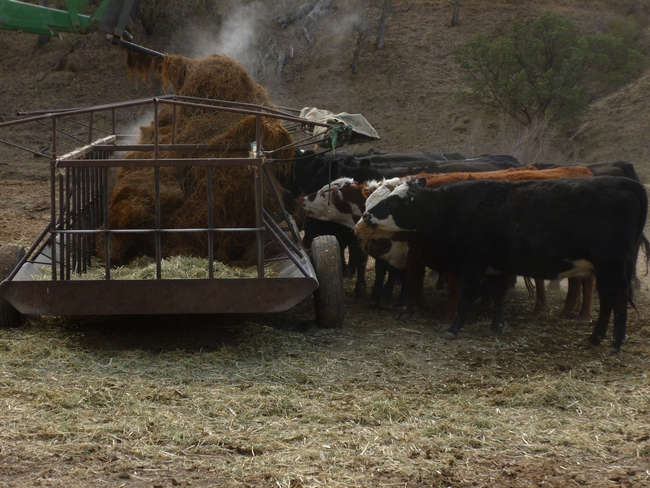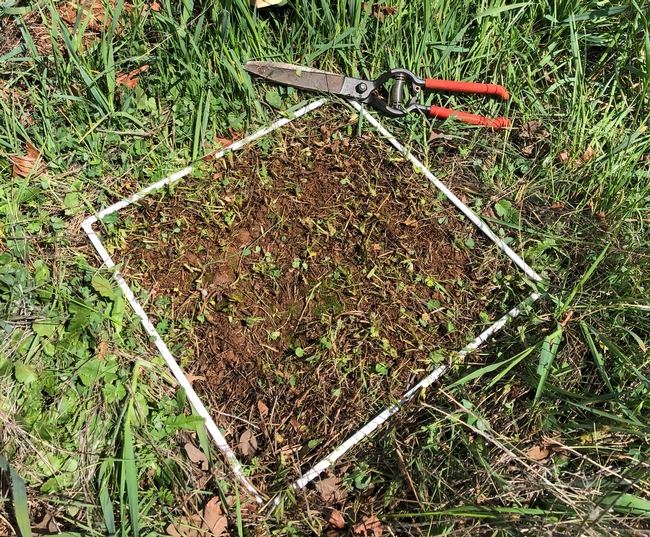Posts Tagged: forage
Rancher wisdom can be improved with science
When California was part of the Wild West, it took a certain amount of guesswork to move cattle from their home range to summer pastures while making sure sufficient forage was left behind to hold the cattle over till fall rainfall spurred new growth.
“Ranchers eyeballed it,” said Theresa Becchetti, UC Cooperative Extension livestock and natural resources advisor. “In time, second-, third-, and fourth-generation ranchers got pretty good at deciding, but UC Cooperative Extension introduced a more scientific approach.”
In the spring of 1936, the USDA Forest Services began measuring ungrazed forage at the San Joaquin Experimental Range in Madera County. The project continues today as a joint effort of UC Cooperative Extension and the USDA Natural Resources Conservation Service.
Sixteen years later, just after the UC Hopland Research and Extension Center was established on Mendocino County rangeland in 1951, another study began; and in the early 1980s, scientists at the UC Sierra Foothills Research and Extension Center in Browns Valley commenced a similar long-term study.
As scientists learned of the multiple factors impacting forage production across the Coast Range and Sierra Nevada foothills, some 70 research sites were identified – most on private land - and consistently monitored. The results show that there is much more to understanding forage growth than looking at a rain gauge.
|
Above, watch a full season of rangeland forage growth in one minute. UC Cooperative Extension rangeland and natural resources advisor Royce Larsen set up a camera to capture images of the daily grass growth on Pozo Peak in San Luis Obispo County. |
While high annual rainfall usually results in high forage production and low annual rainfall generally results in low annual production, there are exceptions. It all depends on the timing of the rainfall.
During the devastating drought of 2011-2016, Becchetti noticed forage production didn't mirror the drought damage to state water resources and mountain forests.
“It was interesting,” said Becchetti. “In a lot of my plots, forage would be close to normal. We got rain when the soil was warming up. If we get rain in the late fall or winter, there is no grass production because it's too cool. If rains come when the temperatures warmed up, the grass takes off.”
The expected variation from climate change is another factor that encourages UCCE scientists to conduct routine forage monitoring.
“When I started 11 years ago, we had some good production years; we had poor years, a couple of normal years,” Becchetti said. “Monitoring is giving us a better snapshot that all of us can use to see the impact of climate change on forage production.”
To develop an accurate picture of forage growth, the research locations are fenced or caged to keep out grazing animals. Grass and forbs within one square foot of the exclosure is clipped to the ground. The vegetation is dried, weighed and the figures logged in a database.
Long-term production data are particularly valuable for the three research stations because daily weather data that are also collected there can be used to determine the effects of rainfall and temperature on annual forage productivity.
Year-to-year variability at the Hopland research site ranged from 900 pounds of forage per acre in the poorest year, up to a 3,500 pounds per acre bounty when conditions were just right. Average annual production at Hopland is 2,399 pounds per acre. At the Sierra Foothill Research and Extension Center, annual forage ranged from a low of 1,071 per acre up to 4,696 pounds per acre. The average annual production there is 2,971 per acre.
“There is no way we could represent the exact forage production across the state, but this does allow us to come up with a percent either below or above normal for a particular area,” Becchetti said.
The monitoring research conducted by UCCE scientists are important to provide guidance to county agricultural commissioners and local Farm Service Agencies.
“If you think about it, so many of our ag commodities are based on weight or volume,” said Scott Oneto, UCCE rangeland and natural resources advisor in El Dorado, Tuolumne, Calaveras and Amador counties, where annual monitoring has been conducted for 25 years. “But annual rangelands are so different when it comes to figuring out whether a given year is average, above average or below average. And when crop insurance is involved, it makes it very difficult for ag commissioners to declare a loss if they don't know what the loss is or if there even was one.”
Becchetti, along with 14 current and former UCCE colleagues, wrote a 12-page review of UCCE's ongoing range forage production study, which includes average production for many of the study sites. ANR Publication 8018 is available for free download from the UC ANR publication catalog.
Livestock producers and rice farmers can work together to solve each other’s problems

The California drought has ranchers desperate for inexpensive livestock feed. Air quality protection regulations that limit rice straw burning leave the rice industry with an abundance of typically low-quality straw to unload. Though it has rarely been done, Nader believes special treatment of rice straw will make it a nutritious cattle food. Two problems solved.
Nader will introduce producers to this new way to get through the drought at a meeting from 9 a.m. to 12 noon July 29 at the Veterans Memorial Hall, 525 W. Sycamore St., Willows, Calif.
When rice straw dries, its value as a forage declines dramatically. For 15 years, UC researchers have been trying to figure out why, but the reason for the significant change is not understood at this time.
“At one time, we thought the problem was silica in the straw,” Nader said. “We grew silica-free rice. That didn't work. We thought it was the crystallinity of molecules in the straw. We parsed apart the plant, and we still don't know.”
Ultimately, it was a rancher who suggested the scientists to put aside their desire to know why quality declines when rice straw dries and look for practical ways to get around it. Nader postponed his retirement to comply.
Normally, rice growers bale the straw two to four days after harvest. Nader and his colleagues instead baled the straw immediately after it exited the grain harvester. They stacked the green straw bales and covered them with a tarp to retain moisture and prevent spontaneous combustion. The result is a product they named “strawlage.” One worry is mold. The researchers found that treating the straw with propionic acid prevents fungus growth.
“We haven't figured everything out, but with the drought conditions as serious as they are, we feel the time is right to share our research with growers,” Nader said. “We invite producers to come to the meeting to see if this will work for their operations. Several producers who have already fed strawlage to their cattle will speak at the meeting about their experiences.”
Nader believes the UC research into using rice straw for livestock feed will be helpful throughout the world.
Asian farmers produce rice straw in great abundance and their livestock would benefit significantly if the farmers worked to maintain the plant's moisture until it reaches cattle feeding troughs.
The July 29 meeting will cover:
- Nutritional advantages of strawlage over rice straw
- The challenges of baling the straw at 50 to 60 percent moisture
- Additives to prevent mold
- How to stake and tarp strawlage
- The costs associated with the practice
- How cows that ate strawlage last year fared
“Our goal is to give producers information that will allow them to make rice strawlage during this fall's harvest,” Nader said. “Both cattle and rice producers are encouraged to attend.”
UCCE farm advisor explains rangeland irony
Forage monitoring at the UC Sierra Research and Extension Center in Browns Valley shows the land produced, on average, 2,984 pounds of vegetation per acre, 93.4 percent of normal, according to an article published today in Capital Press. That may sound fantastic - 93.4 percent looks like an A to me. But UCCE farm advisor Larry Forero said that the growth came too late for most ranchers.
In fact, in nearby Tehama County, officials are seeking a federal disaster declaration because of drought damage to its rangelands. Reporter Tim Hearden wrote that neighboring counties may follow suit.
The problem may not be too little rain, but the timing of the rain. Much of the vegetation grew after April and May storms, Forero said. By that time, some ranchers - concerned about the lack of forage on the foothill land - had already moved their cattle to higher-elevation summer pastures or to irrigated pastures.
The fact that vegetation was left behind may prove helpful in the fall when cattle return to the range. But Northern California ranchers took another blow when it rained in early June.
This late rain can sometimes do more harm than good, Forero told the reporter. When the grass is dry, rain can leach it and reduce its nutritional value.
"This is an incredibly complicated business," Forero told me when we spoke this morning.

Forage was below average each month of '09 season.
